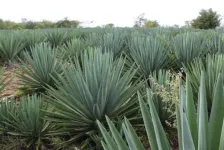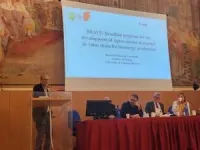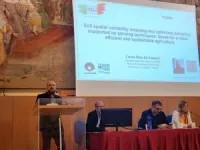(Press-News.org) Climate change has caused an increase in the semi-arid climate region in Brazil. Data from the National Center for Monitoring and Warning of Natural Disasters (CEMADEN) and the National Institute of Space Research (INPE) in the South American country indicate an expansion of 7,500 square kilometers per year since 1990, which is equivalent to five times the area of the city of São Paulo. A similar phenomenon has been observed in some regions of Europe and North Africa.
With this in mind, and with the desire to find solutions to mitigate climate change, a group of Brazilian researchers began searching for plants with the potential to be used to generate bioenergy and that could be grown where the climate is not favorable for sugarcane. They decided to study Agave, a genus of succulent plants that includes more than 200 species and is widely used in Mexico to make tequila.
The work is being carried out with the support of FAPESP within the Brazilian Agave Development (BRAVE) project, a partnership involving the State University of Campinas (UNICAMP), the company Shell and other teaching and research institutions such as Senai CIMATEC (the Integrated Manufacturing and Technology Campus of the National Industry Service, the non-profit initiative of the CNI, the National Confederation of Industry), the Federal University of Recôncavo da Bahia (UFRB), the University of São Paulo (USP), and São Paulo State University (UNESP). The latest results were presented on October 14th during FAPESP Week Italy by Marcelo Falsarella Carazzolle, professor at the UNICAMP’s Institute of Biology (IB) who coordinates the initiative alongside Gonçalo Pereira, also from IB-UNICAMP. The event, which ended on October 15th, was held in partnership with the Alma Mater Studiorum - Università di Bologna (UNIBO).
“In Brazil, the main species grown is Agave sisalana, whose leaves are used to make sisal fiber. However, this process makes use of only 4% of the plant, generating a large amount of waste that’s now put in the field to be degraded,” said the researcher. “However, it’s possible to generate bioenergy from both the juice extracted from the leaves, which is rich in inulin, a type of sugar, and from the bagasse, which is rich in cellulose. In addition to the leaves, agave pine cones also accumulate a lot of inulin that can be used. The plants require less water and fertilizer [compared to sugarcane], grow in five years, and generate 800 tons of biomass per hectare.”
The group’s research is funded by FAPESP through projects 20/02524-0, 22/09394-5, 23/16853-4 and 24/06624-0.
The group has collected different species of agave throughout Brazil and in countries such as Mexico and Australia to create a germplasm bank. And it’s investigating the phenotype of the plants, evaluating its sugar composition, photosynthesic and growth rates, how much it needs irrigation, and its relationship with the soil, among other factors. Based on this information, it’s developing strategies to help overcome the challenges involved in transforming agave into the “sugarcane of the sertão” – the sertão is the drought-ridden hinterland of Brazil’s Northeast region.
One of the main difficulties is that the yeast normally used in ethanol production, Saccharomyces cerevisiae, is unable to metabolize inulin, which is a fructose polymer and must be hydrolyzed to release fermentable sugars. The group has developed a genetically modified strain for this purpose and a patent for the process was filed with the National Institute of Industrial Property (INPI). Modified yeasts have also been developed and patented to metabolize xylose, one of the sugars present in bagasse (read more at: agencia.fapesp.br/52896).
Another challenge has been the search for biostimulants and fertilizers capable of accelerating the agave’s growth rate, which is considered slow. “We’re patenting a compound that doubles [the growth rate], and we’ve identified four others that have shown promise, evaluating the molecular bases and their mechanisms of action,” he said.
Another breakthrough was the development of a plant genetically modified to become tolerant to glyphosate, one of the most widely used herbicides in the world. “We patented the protocol for the genetic transformation of agave because even in the semi-arid region there’s a lot of competition with weeds.”
The ultimate goal of the project is to make it possible to produce not only ethanol from agave but also biomethane, biohydrogen and biochar.
Precision agriculture
Carazzolle’s presentation was part of a panel discussion on the agri-food system and sustainable development. Other participants were Lucas Rios do Amaral, from the Faculty of Agricultural Engineering (FEAGRI) at UNICAMP, and Valda Rondelli and Matteo Vittuari, both from the Department of Agricultural and Food Sciences at UNIBO. The panel was coordinated by José Paulo Molin, professor at the Luiz de Queiroz College of Agriculture (ESALQ-USP).
“Agriculture has grown rapidly in Brazil. Production in the country began to increase around 1950-1960. The starting point of this process was the beginning of mechanization, which made it possible to cultivate large areas. And this is closely linked to the arrival of immigrants, mainly from Italy and Germany. And they’re still in the country today, in the form of large companies [producing agricultural machinery],” Molin said. “Now we’re taking the next step, which is automation. This involves, for example, artificial intelligence tools embedded in the machines,” said the ESALQ-USP professor, introducing the topic of Amaral’s presentation, which highlighted the results of a project funded by FAPESP.
“We need to increase food production because the population is growing. But we need to optimize the use of natural resources and make the process more sustainable. Fertilization is one of the most important resources for us because in Brazil we have poor soils. Inappropriate use of fertilizers increases production costs and has an impact on the environment. In this scenario, precision agriculture becomes an alternative,” Amaral explained.
There is great variability in soil quality in agricultural regions, and treating the entire area homogeneously is a waste of resources, the researcher added. To avoid this, farmers need to hire companies that assess this variability by manually collecting numerous samples, which are then analyzed in a laboratory. The results provide a “prescription map” that indicates where more or less of a given product needs to be applied.
The goal of Amaral’s project is to optimize sample collection using data obtained from remote sensing (satellites and drones) and proximal sensing (equipment on tractors, for example). “My focus is not on providing the map for the farmer, but on supporting the service providers who do this. Hundreds of companies collect samples to generate the map. I’m trying to make this process more efficient so that fewer samples need to be collected to generate an even more accurate map,” she explained to Agência FAPESP.
Valda Rondeli presented projects linked to the development of autonomous vehicles for agricultural use, including tractors. The idea is to use intelligent equipment to obtain data and develop systems that can support decision-making on farms. “We’re in the age of big data. We need to use artificial intelligence to handle the data and get the right information at the right time,” she said.
Matteo Vittuari spoke about how to stimulate public policies that promote the transformation of the food system and sustainable development. He also talked about how to engage citizens and institutions in this process and how to measure the impact of these strategies.
END
Brazilian researchers work to transform agave into the ‘sugarcane of the sertão’
In Brazil, the main species grown is Agave sisalana, whose leaves are used to make sisal fiber. The latest studies results were presented on October 14th during FAPESP Week Italy.
2024-10-15
ELSE PRESS RELEASES FROM THIS DATE:
Seizures caused by children swallowing medications or illegal substances doubled over 15-year period
2024-10-15
Copenhagen, Denmark: New data shows that the number of children suffering a seizure after swallowing medications or illegal substances has doubled between 2009 and 2023 in the US. The findings were presented today (Wednesday) at the European Emergency Medicine Congress.
The most common substances involved in these poisonings include over-the-counter antihistamines, prescription antidepressants and painkillers, and illegal synthetic cannabinoids.
Dr Conner McDonald from the University of Virginia School of Medicine told the Congress: “Seizure is one of the most severe symptoms a poisoned ...
Increase in air pollution corresponds with more patients at the hospital emergency department
2024-10-15
Copenhagen, Denmark: Increases in levels of particulate matter in the air, even within World Health Organization guidelines, correspond with an increase in the number of patients going to the hospital emergency department, according to research presented at the European Emergency Medicine Congress today (Wednesday).
The study found links particularly between air pollution and cases of trauma, breathing difficulties and skin conditions.
The research was presented by Dr Andrea Rossetto an emergency medicine resident at University of Florence and Careggi University Hospital, Florence, Italy, and a PhD Student at Queen Mary University of London, UK.
Dr ...
NASA, NOAA: Sun reaches maximum phase in 11-year solar cycle
2024-10-15
In a teleconference with reporters on Tuesday, representatives from NASA, the National Oceanic and Atmospheric Administration (NOAA), and the international Solar Cycle Prediction Panel announced that the Sun has reached its solar maximum period, which could continue for the next year.
The solar cycle is a natural cycle the Sun goes through as it transitions between low and high magnetic activity. Roughly every 11 years, at the height of the solar cycle, the Sun’s magnetic poles flip — on Earth, that’d be like the ...
Scientists at ChristianaCare gene editing institute use CRISPR tools to safely disable gene mutation linked to treatment-resistant melanoma
2024-10-15
Scientists at ChristianaCare Gene Editing Institute Use CRISPR Tools to Safely Disable Gene Mutation Linked to Treatment-Resistant Melanoma
Study finds CRISPR restores the ability for cancer treatments to attack melanoma cancer cells with precision-guided gene edit that ignores healthy cells
Wilmington, DE, OCTOBER 15, 2024 -- In a potential advance for melanoma patients, researchers at ChristianaCare’s Gene Editing Institute have used CRISPR gene editing ...
Study busts myths about cause of gout
2024-10-15
A major international study has found gout is a chronic illness where genetics is a major cause, rather than lifestyle choices of the sufferer.
Led by University of Otago researchers, the genome-wide association study, published in Nature Genetics, analysed the genetic information of 2.6 million people.
Researchers analysed amalgamated DNA data sets from around the world. About three quarters of the data was from customers of 23andMe, Inc, a direct-to-consumer genetics and preventative health company, who consented to participate in research.
They found inherited genetics is an important part ...
Machine learning analysis sheds light on who benefits from protected bike lanes
2024-10-15
A new analysis from University of Toronto Engineering researchers leverages machine learning to help answer a thorny question: where should new protected bike lanes be placed to provide maximum benefit?
“Right now, some people have really good access to protected biking infrastructure: they can bike to work, to the grocery store or to entertainment venues,” says Madeleine Bonsma-Fisher, a postdoctoral fellow in the Department of Civil & Mineral Engineering and lead author of a new paper published in the Journal of Transport Geography.
“More ...
New research reveals how large-scale adoption of electric vehicles can improve air quality and human health
2024-10-15
A new study from the University of Toronto's Department of Civil & Mineral Engineering suggests that large-scale adoption of electric vehicles (EVs) could lead to significant population-level health benefits.
The research team used computer simulations to show that aggressive electrification of the U.S. vehicle fleet, coupled with an ambitious rollout of renewable electricity generation, could result in health benefits worth between US$84 billion and 188 billion by 2050.
Even scenarios with less aggressive grid decarbonization mostly predicted health benefits running into the tens of billions of dollars.
“When ...
Florida Inventors Hall of Fame invites nominations for 2025 inductees
2024-10-15
TAMPA, Fla. (Oct. 15, 2024) -- The Florida Inventors Hall of Fame is inviting nominations for the 2025 class of inductees. This award recognizes distinguished inventors with a connection to Florida, whose achievements have advanced quality of life for the state and the nation.
“Inductees to the Florida Inventors Hall of Fame represent some of our nation’s greatest inventors from across academia, industry and government,” said Paul Sanberg, chair of the Florida Inventors Hall of Fame Advisory Board and president of the National Academy of Inventors. “Their achievements underscore the critical role that innovation plays in driving ...
Election officials can boost voter trust in delayed results with early communication
2024-10-15
In recent U.S. elections, results often took days to finalize, fueling voter distrust in the electoral process and ballot outcomes. Now, research from the Yankelovich Center for Social Science Research at UC San Diego shows that a simple, proactive message from election officials – ahead of Election Night – can effectively reduce this distrust.
The study, published in PNAS Nexus, reveals that when voters are informed in advance that counting ballots accurately takes time and there are security measures in place, their trust in the process remains steady, even when results are delayed.
“Election officials ...
Rice-led research will leverage responsible AI to enhance coastal communities’ severe storm response
2024-10-15
HOUSTON – (Oct. 15, 2024) – An interdisciplinary team of Rice University engineers and collaborators led by Jamie Padgett has won $1.5 million from the National Science Foundation (NSF) to improve the safety and resiliency of coastal communities facing compounded risk from hazardous weather events.
Padgett, together with Ben Hu and Avantika Gori at Rice, David Retchless at Texas A&M University at Galveston and community partners, will leverage responsible artificial intelligence (AI), hazard and resilience models ...
LAST 30 PRESS RELEASES:
Superradiant spins show teamwork at the quantum scale
Cleveland Clinic Research links tumor bacteria to immunotherapy resistance in head and neck cancer
First Editorial of 2026: Resisting AI slop
Joint ground- and space-based observations reveal Saturn-mass rogue planet
Inheritable genetic variant offers protection against blood cancer risk and progression
Pigs settled Pacific islands alongside early human voyagers
A Coral reef’s daily pulse reshapes microbes in surrounding waters
EAST Tokamak experiments exceed plasma density limit, offering new approach to fusion ignition
Groundbreaking discovery reveals Africa’s oldest cremation pyre and complex ritual practices
First breathing ‘lung-on-chip’ developed using genetically identical cells
How people moved pigs across the Pacific
Interaction of climate change and human activity and its impact on plant diversity in Qinghai-Tibet plateau
From addressing uncertainty to national strategy: an interpretation of Professor Lim Siong Guan’s views
Clinical trials on AI language model use in digestive healthcare
Scientists improve robotic visual–inertial trajectory localization accuracy using cross-modal interaction and selection techniques
Correlation between cancer cachexia and immune-related adverse events in HCC
Human adipose tissue: a new source for functional organoids
Metro lines double as freight highways during off-peak hours, Beijing study shows
Biomedical functions and applications of nanomaterials in tumor diagnosis and treatment: perspectives from ophthalmic oncology
3D imaging unveils how passivation improves perovskite solar cell performance
Enriching framework Al sites in 8-membered rings of Cu-SSZ-39 zeolite to enhance low-temperature ammonia selective catalytic reduction performance
AI-powered RNA drug development: a new frontier in therapeutics
Decoupling the HOR enhancement on PtRu: Dynamically matching interfacial water to reaction coordinates
Sulfur isn’t poisonous when it synergistically acts with phosphine in olefins hydroformylation
URI researchers uncover molecular mechanisms behind speciation in corals
Chitin based carbon aerogel offers a cleaner way to store thermal energy
Tracing hidden sources of nitrate pollution in rapidly changing rural urban landscapes
Viruses on plastic pollution may quietly accelerate the spread of antibiotic resistance
Three UH Rainbow Babies & Children’s faculty elected to prestigious American Pediatric Society
Tunnel resilience models unveiled to aid post-earthquake recovery
[Press-News.org] Brazilian researchers work to transform agave into the ‘sugarcane of the sertão’In Brazil, the main species grown is Agave sisalana, whose leaves are used to make sisal fiber. The latest studies results were presented on October 14th during FAPESP Week Italy.




